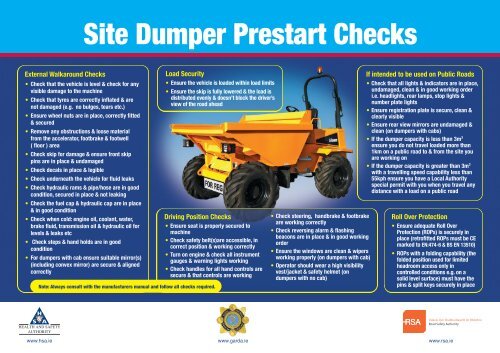Site Dumper and 360 Excavators Pre-Start checks Poster
Site Dumper and 360 Excavators Pre-Start checks Poster
Site Dumper and 360 Excavators Pre-Start checks Poster
Create successful ePaper yourself
Turn your PDF publications into a flip-book with our unique Google optimized e-Paper software.
<strong>Site</strong> <strong>Dumper</strong> <strong>Pre</strong>start Checks<br />
External Walkaround Checks<br />
• Check that the vehicle is level & check for any<br />
visible damage to the machine<br />
• Check that tyres are correctly inflated & are<br />
not damaged (e.g. no bulges, tears etc.)<br />
• Ensure wheel nuts are in place, correctly fitted<br />
& secured<br />
• Remove any obstructions & loose material<br />
from the accelerator, footbrake & footwell<br />
( floor ) area<br />
• Check skip for damage & ensure front skip<br />
pins are in place & undamaged<br />
• Check decals in place & legible<br />
• Check underneath the vehicle for fluid leaks<br />
• Check hydraulic rams & pipe/hose are in good<br />
condition, secured in place & not leaking<br />
• Check the fuel cap & hydraulic cap are in place<br />
& in good condition<br />
• Check when cold: engine oil, coolant, water,<br />
brake fluid, transmission oil & hydraulic oil for<br />
levels & leaks etc<br />
• Check steps & h<strong>and</strong> holds are in good<br />
condition<br />
• For dumpers with cab ensure suitable mirror(s)<br />
(including convex mirror) are secure & aligned<br />
correctly<br />
Driving Position Checks<br />
• Ensure seat is properly secured to<br />
machine<br />
• Check safety belt(s)are accessible, in<br />
correct position & working correctly<br />
• Turn on engine & check all instrument<br />
gauges & warning lights working<br />
• Check h<strong>and</strong>les for all h<strong>and</strong> controls are<br />
secure & that controls are working<br />
Note: Always consult with the manufacturers manual <strong>and</strong> follow all <strong>checks</strong> required.<br />
Load Security<br />
• Ensure the vehicle is loaded within load limits<br />
• Ensure the skip is fully lowered & the load is<br />
distributed evenly & doesn’t block the driver’s<br />
view of the road ahead<br />
• Check steering, h<strong>and</strong>brake & footbrake<br />
are working correctly<br />
• Check reversing alarm & flashing<br />
beacons are in place & in good working<br />
order<br />
• Ensure the windows are clean & wipers<br />
working properly (on dumpers with cab)<br />
• Operator should wear a high visibility<br />
vest/jacket & safety helmet (on<br />
dumpers with no cab)<br />
If intended to be used on Public Roads<br />
• Check that all lights & indicators are in place,<br />
undamaged, clean & in good working order<br />
i.e. headlights, rear lamps, stop lights &<br />
number plate lights<br />
• Ensure registration plate is secure, clean &<br />
clearly visible<br />
• Ensure rear view mirrors are undamaged &<br />
clean (on dumpers with cabs)<br />
• If the dumper capacity is less than 3m 3<br />
ensure you do not travel loaded more than<br />
1km on a public road to & from the site you<br />
are working on<br />
• If the dumper capacity is greater than 3m 3<br />
with a travelling speed capability less than<br />
55kph ensure you have a Local Authority<br />
special permit with you when you travel any<br />
distance with a load on a public road<br />
Roll Over Protection<br />
• Ensure adequate Roll Over<br />
Protection (ROPs) is securely in<br />
place (retrofitted ROPs must be CE<br />
marked to EN:474-6 & BS EN 13510)<br />
• ROPs with a folding capability (the<br />
folded position used for limited<br />
headroom access only in<br />
controlled conditions e.g. on a<br />
solid level surface) must have the<br />
pins & split keys securely in place<br />
www.hsa.ie www.garda.ie www.rsa.ie
<strong>360</strong> Excavator (Tracked) <strong>Pre</strong>start Checks<br />
External Walkaround Checks<br />
• Check for any visible damage<br />
to the machine<br />
• Check track assembly for<br />
damage, tightness etc.<br />
Visually check rollers, idlers,<br />
sprockets etc. are in order<br />
• Check underneath machine<br />
for fluid leaks<br />
• Check when cold, engine oil,<br />
coolant, water, brake fluid,<br />
transmission oil <strong>and</strong><br />
hydraulic oil for levels <strong>and</strong><br />
leaks etc.<br />
• Check hydraulic rams <strong>and</strong><br />
pipe/hose are in good<br />
condition, secured in place<br />
<strong>and</strong> not leaking<br />
• Check decals in place <strong>and</strong><br />
legible<br />
• Check the fuel cap <strong>and</strong><br />
hydraulic cap are in place<br />
<strong>and</strong> in good condition<br />
• Check work attachment<br />
(bucket, rock breaker etc.) is<br />
properly secured <strong>and</strong> correct<br />
pins <strong>and</strong> clips are securely in<br />
place<br />
• Check condition of ground<br />
engaging tools i.e. – tips,<br />
adapters not broken or<br />
excessively worn etc.<br />
• Check ‘Falling Object<br />
Protection’ (FOPs) system is<br />
in good order (where<br />
required)<br />
• Remove any obstructions &<br />
loose materials from<br />
accelerator <strong>and</strong> foot brake<br />
• Check steps <strong>and</strong> h<strong>and</strong> holds<br />
are in good condition<br />
• Ensure check valves are in<br />
place on hydraulic system<br />
where required<br />
• Check pipes <strong>and</strong> cables are<br />
not frayed or broken<br />
• Ensure quick hitch<br />
mechanism is free from<br />
obstruction & loose<br />
materials. Ensure quick hitch<br />
springs (manual quick hitch)<br />
are in place & not damaged<br />
• Check all lights are in good<br />
order<br />
• Check reversing camera,<br />
where fitted, is in place <strong>and</strong><br />
undamaged<br />
When used as crane<br />
• Ensure Safe Working Load<br />
information is readily accessible<br />
• Ensure the vehicle/ machine is<br />
loaded within limits<br />
In Cab Checks (Running<br />
Checks)<br />
• Check driving controls are in good<br />
working orderCheck all instrument<br />
gauges & warning lights are working<br />
• Check/Sound movement alarm &<br />
ensure it is audible <strong>and</strong> working<br />
correctly<br />
• Check control lever lock arm (“dead<br />
man lever”) is operational<br />
• Ensure the load is not<br />
obstructing drivers view<br />
• Ensure a competent<br />
slinger/signaller used<br />
• Check the overload warning<br />
devices are working correctly<br />
In Cab Checks<br />
(prior to full ignition)<br />
• Check safety belt(s) accessible,<br />
in correct position & working<br />
correctly<br />
• Check seat is secure <strong>and</strong> in good<br />
working condition<br />
• Ensure heater is in good working<br />
condition<br />
• Ensure windows are clean, not<br />
cracked & wipers are working<br />
• Check/Sound horn & ensure it is<br />
audible <strong>and</strong> working correctly<br />
• Turn on <strong>and</strong> check that all lights,<br />
including flashing beacons, are<br />
working<br />
• Check h<strong>and</strong>les for all h<strong>and</strong><br />
controls are secure <strong>and</strong> that<br />
controls are working<br />
• Check all mirrors (including<br />
convex mirror) are secured,<br />
unbroken & aligned correctly<br />
• Check reversing camera <strong>and</strong><br />
camera screen, where fitted, are<br />
working<br />
• Check control lever lock arm<br />
(“dead man lever”) is in place<br />
<strong>and</strong> not damaged<br />
Note: Always consult with the manufacturers manual <strong>and</strong> follow all <strong>checks</strong> required.<br />
www.hsa.ie

















